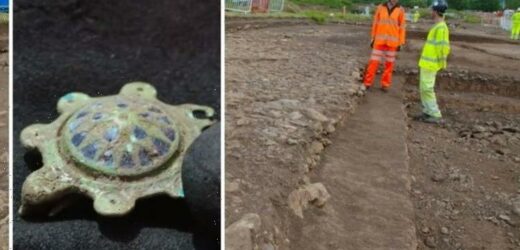Digging for Britain: Excavation finds old Roman roads
We use your sign-up to provide content in ways you’ve consented to and to improve our understanding of you. This may include adverts from us and 3rd parties based on our understanding. You can unsubscribe at any time. More info
The Romans arrived in Britain in 43AD, and six years later they reached Somerset and the Mendip Hills. They came to Somerset to mine galena, the ore that is smelted to produce lead. Such an important industry would surely have led to thriving communities in the surrounding area. Yet little evidence has been found, until now.
In a nearby valley, trenches were being dug for new, underground electricity cables along the route of National Grid’s new powerline in the Mendips.
Dozens of archaeologists scoured the ground in a two-year process, that started in 2019, after surveys revealed signs of human activity.
The team were joined by the camera crew of the BBC’s recent Digging for Britain documentary, which aired this week.
Professor Alice Roberts, the programme’s presenter, said: “The archaeologists expected to find some evidence of farming communities, but what they found stunned everyone.”
Mike Glyde, a lead archaeologist for the National Grid, welcomed Prof Roberts to the excavation site.


He said: “This particular area was identified requiring excavation in advance of construction, and what we’ve found has far surpassed anything any of us could have really predicted.
“We have one and a half metres of unbroken stratigraphy dating from the late Iron Age right through to the late Saxon and medieval period.
“And we’ve got a totally unbroken settlement on site. So we’ve got a huge amount of social and economic development of a town in fine detail.”
The site sits just outside Winscombe in Somerset, not far from the ancient lead mines at Charterhouse-on-Mendip.
Roman remains have been found in the immediate vicinity of the site, but nothing on a scale the National Grid teams discovered.

Mr Glyde explained: “We are looking at a completely unknown Roman town.”
Romans famously took their road-building extremely seriously, and the discovery of one such road offered a stunning insight into the life they lived two thousand years ago.
Bob McIntosh is leading the archaeology team. He explained they had found four 4th Century roads, dating to Constantine’s rule.
Constantine was crowned in Britain in 306AD before conquering the rest of the Roman Empire.
DON’T MISS:
Archaeology: Coin discovery could ‘rewrite idea of London’s history’ [INSIGHT]
Archaeologists blown away by ‘once in a lifetime’ Roman discovery [REVEALED]
Archaeology: ‘Unexpected’ Solent discovery rewrites farming history [QUOTES]

The discovery, Mr McIntosh explained, fits “perfectly” with their theory that the site went from an “urban sprawl up the valley to big roads being built through, demolishing people’s houses — which you can see the foundations of sticking out through the road surface”.
His reign kickstarted an era of economic prosperity for Roman Britons, not least those living in this Somerset settlement.
Hundreds of coins were discovered, including several with Constantine’s face etched onto them.
The settlement opens up ideas of previously unknown trade routes that the Romans might have used.

Cat Lodge, a senior archaeologist at North Somerset Council, told the documentary: “These routes are almost completely new to us.
“This roadside settlement is giving us the possibility that there was trade-off Mendip into the Bristol Channel.”
The nearest major trade route for the lead mines of the Mendip hills in Roman times was the Fosse Way, which linked Exeter to Lincoln via Ilchester, Bath, Cirencester and Leicester.
The roadside settlement, however, suggests another trade route would have taken lead from the Mendips to the coast, where it was transported by ship across the rest of the Roman Empire.
Further evidence at the site proved it was a bustling community. They found evidence of a butchery and a series of partly intact wells.
Prof Roberts explained: “The mix of light industry and domestic luxury suggests this was an affluent community with this major road as its main artery.”
Mr McIntosh added: “The people living here, they’re not directly lead miners, they’re living too well for that.
“These are merchants or accountants or some secondary industry that is making money off of those lead mines, I would assume.”
According to SomersetLive, all excavations have now been completed and the underground cables are now in place.
Source: Read Full Article


